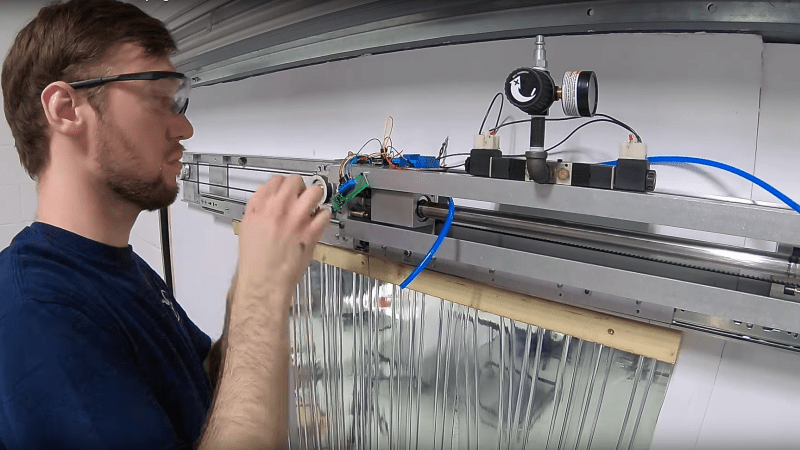When [John Saunders] wanted an automatic door for his shop, rather than settle for a commercial unit, he designed and built a proximity-sensing opener to ease his passing. Sounds simple, right?
Fortunately for us, there are no half-measures at Saunders Machine Works, thanks to the multiple Tormach workcells and the people who know how to use them. The video below treats us to quite a build as a result; the first part is heavy on machining the many parts for the opener, so skip ahead to 8:33 if you’re more interested in the control electronics and programming.
The opener uses time-of-flight distance sensors and an Arduino to detect someone approaching, with a pneumatic cylinder to part a plastic strip curtain. [John] admits to more than a little scope creep with this one, which is understandable when you’ve got easy access to the tools needed to create specialized parts at will.
In the end, though, it works well for everyone but [Judd], the shop dog, and it certainly looks like it was a fun build to boot. [John]’s enthusiasm for mixing machining and electronics is infectious; check out his automated bowl feeder for assembly line use.
















Now, someone seeds to add the Star Trek door sound
Or, even better, Heart-of-gold’s door sound. Plus build depressed Marvin.
Now those there sound like a surefire path to disaster, fortunately you can mollify that with a Pan-Galactic Gargle-Blaster.
How about having having it go “sshhh” and have it activate by saying “ssshhh” like Flying High 2 (Airplane 2 for you Yanks)
https://www.youtube.com/watch?v=L9ilm8PEJlQ
Ummm, why does he need the strips now? Why not make it solid?
Fire safety, for one
Fire safety? I’m sure full metal doors are more fire proof than thin strips of plastic. And automated doors can be pushed open manually just like any other door too.
I would have expected more of Saunders.
The gears in the middle are 100% useless and a possible place for wear & noise.
If you put a timing belt (or a piece of string) around 2 pulleys and the top part is moving left, then the bottom part is moving down. This has been used in motorized curtains since before I was born.
“….to ease his passing. ” is a bit ominous. Sounds more like euthanasia than automation.
The Carousel is in the other room.
Sorry, worked a little LOTR reference in there:
https://youtu.be/oC56Zm8d54M?t=35s
I’ve always enjoyed his channel, started with his early tutorial on building x-y-z mill. Back to this build, definitely overkill, but that’s okay. One of the oversights, or at least it’s not in the plans/discussion, is dust exclusion. The entire build should have been shielded with some sort of acrylic at the least. Oh, and because I know someone else will say it… is there a power/maintenance switch somewhere? Lastly, those strips do eventually catch on things so hopefully each strip has a break-away threshold designed-in.
Overall, a great video.
Can’t be A.R.S.E.d to deal with those darn annoying rubber strip anymore, eh? :)